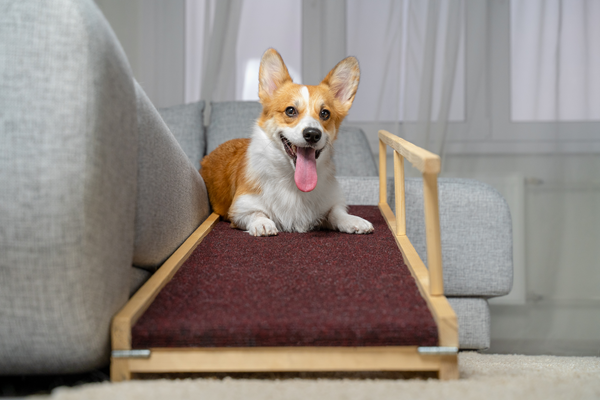
Whether it be arthritis, neurologic disease or a soft tissue strain, many pets will have trouble moving at some point in their life. But because of their inherent stoic natures or evolutionary need to hide problems, they won’t always make it obvious that they’re having trouble in their home environment.
If you can create a living space that helps them with their normal routines, it can make a great difference in their quality of life and help increase their lifespan. Here are a few ways you can make your home more comfortable for your dog.
Make floors and stairs non-slip
Although beautiful and durable, hard flooring like hardwood, laminate, or tile is not good for dogs. It’s more difficult to walk and run on hard floors securely. Pets with mobility concerns often walk cautiously on these floors, with a short stride and hunched back to guard against falling. This posture can lead to stiffness and soreness in their muscles and, ultimately, to reduced activity around the house throughout the day, causing stiff, sore joints. This is often why older dogs appear to sleep more.
To make your hard floors and stairs easier to navigate, you could carpet your whole home or, more realistically, you could lay down area rugs and runners in areas where your dog spends the most time. Make sure those rugs/runners are non-slip and there aren’t any raised corners or edges that could trip your dog. If your dog still jumps on or off furniture, make sure you have non-slip rugs in the area to prevent slipping.
Your veterinarian may recommend that your pet avoid all unnecessary stairs. In those cases, installing baby gates may be the best solution. You can help your pet up and down the stairs, when needed, with a harness designed to support their weight comfortably with little strain on your back. There are also stair lifts for dogs, or you could consider a ramp for outside stairs.
Trim your dog’s nails regularly
Leaving long nails on a dog is akin to putting high heels on a grandparent and asking them to walk on an ice rink! Just don’t do it. Keep their nails short and trim any fur that extends between their toes to improve traction and mobility around the home. Most dogs need their nails trimmed at least once a month. If your dog is stressed with nail trims, ask your veterinarian about anti-anxiety medications and training tips to help your dog accept this needed care.
Give your dog some extra traction
Another way to give your dog extra grip at home is to apply nail caps, pad coverings, or boots. Different options work differently on each pet, so talk to your dog’s veterinarian or veterinary rehabilitation therapist before trying these options.
Choose a good bed and make it accessible
A good bed can do a lot to ease aching bones and muscles. Although dogs often like to lie on hard, cool surfaces, this is not ideal for a mobility-challenged dog. Choose a bed that they can get into easily, without having to climb over or onto something (e.g., a recessed orthopedic bed).
Use bedding that doesn’t retain heat – especially in warmer climates. The bed or bed cover should be machine washable to protect against urine or fecal accidents. Such accidents can happen more frequently in dogs with mobility compromise.
If your dog sleeps on your bed or other furniture, and your veterinarian says it is safe to continue, you can teach them to use stairs or ramps specifically made to help them get up and down. You may need to spend some time encouraging your dog to use them.
Elevate their food and water
It can become very difficult for a dog to eat or drink from bowls on the floor. Elevating the bowls to a level that is more comfortable for them can make it easier for them to eat and drink. A good level is often between their elbow and shoulder.
Dogs who find it hard to drink or go to the bathroom will often drink less. This can lead to several problems, including urinary tract infections, dehydration, and possibly worsening of kidney disease.
Help them get to the bathroom
You may need to help and encourage your older pet to go outside more frequently to eliminate. Think of what you did when they were a puppy – taking them outside every 2-3 hours throughout the day to avoid elimination in the house. They may need a harness that offers comfortable support around their hind end if they have trouble holding the posture to urinate or defecate. Talk to your veterinarian or rehabilitation therapist about best options for your dog.
Look at things from their point of view
Get down at your dog’s level and see what they need to walk around or over.
- As much as possible, minimize any clutter or confined spaces that require sudden changes in direction, which can be hard on the joints or cause falls.
- If there are any pointy or sharp edges that the dog may hit or fall into, like fireplace hearths or hard furniture corners, find ways to pad them. Get creative! Pool noodles can be helpful at cushioning these areas.
- Video your dog moving around your home in slow motion; pay close attention to their feet and posture, and how they change on different surfaces. A shorter stride or hunching around their shoulders or back may indicate your dog is having trouble navigating that area.
Just like humans, dogs benefit greatly from consideration and accommodation of their physical limitations. With a bit of effort, you can help your dog live comfortably at home, even when they struggle with getting around.
